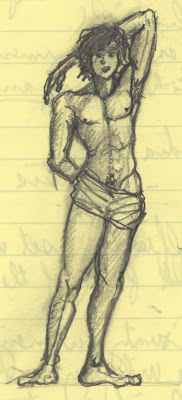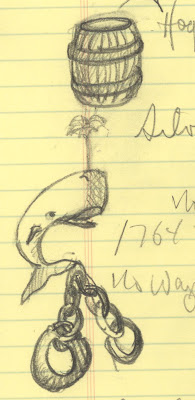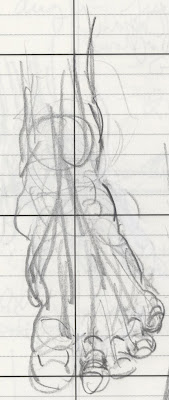My doodles fall into four categories: fanciful creations, applications of art principles or concepts I am studying, drawings related to the lecture (often sketches from slides or graphic representations of some point), and finally portrait studies of teachers or students. Here are some doodles from the last ten years in class.
2001

One can study a disk in three dimensional space by drawing flowers. The bird probably started as a random mark on the paper.
2002

In the midst of a PowerPoint, I sketched a picture of this famous, Utah Senator, a study in anatomy, of shape and value, as well as a snapshot from history.

More famous Utahans, more chance to study some principals of art.

As a University lecture winds on through the cold winter night, I dream of Camp Loll and our mighty mascot.

A study of the human figure. So many parts to keep in mind and in proportion. There are rules for keeping everything in place. The challenge is keeping the rules in mind.

Morning Dove.

My effort to portray a nun. My one time in the hospital, I was visited by a nun. She seemed a saint to me.
2003

One of my students takes a test.

Another, Braden, before his big hair cut.

One way of showing depth is overlapping.
2004

I was thinking of the Trojan Horse as I told the story of Aeneas one more time.

Robert Beverly Hale suggests one practice drawing ribbons over cylinders to understand depth and perspective.
2005
In 2005 I took a series of seminars on Revolutions.
In 2005 I took a series of seminars on Revolutions.

The Guillotine

A study of a cube in space.

Pants are revolutionary to the French.

This is my sketch of Linen, he lied a revolution.

My heart wasn't into the revolutions threatening in Iraq, rather into mastering the proportion and locations of the features on face.

The professor drones on and on about saving the environment; the infinite value of the spotted owl. I try to come up with some practical uses for spotted owls; a study in perspective.

Both Troqua and Bpah Oh Quaidt stood "like a wedge of polished cedar".
This is not Dr. Sessions, rather Dr. Sechaswari (sp). I was confused because both are called Sess. He is a Hindu, hence my attempt at Vishnu.
2006
I spend a lot of time trying to learn to draw the human figure. I believe it to be the most important form in the world, the image of God.

This is a favorite pose - arm over the head - it allows me to draw the muscles of the arm and the side of the body usually covered when the arms are both held to the side. Placing one hand behind the back is a cop-out. It's much easier to draw a hand you can't see.

Hale also explains that there are only a few basic three dimensional shapes that are found in the human form. By mastering all of them, one can master the figure. They are the cube, the sphere, the cone, the egg or oval, the spool and the donut.

The floating cube, an illusion of perspective.

American goes whaling.

Grapes are spheres.

This moose has four legs, he is just standing at attention and you can't see the ones behind.

This is a favorite pose - arm over the head - it allows me to draw the muscles of the arm and the side of the body usually covered when the arms are both held to the side. Placing one hand behind the back is a cop-out. It's much easier to draw a hand you can't see.

Hale also explains that there are only a few basic three dimensional shapes that are found in the human form. By mastering all of them, one can master the figure. They are the cube, the sphere, the cone, the egg or oval, the spool and the donut.

The floating cube, an illusion of perspective.

American goes whaling.

Grapes are spheres.

This moose has four legs, he is just standing at attention and you can't see the ones behind.
2007

Basic shapes as found on the face.

Putting the shapes together to make the form is the challenge. One must know so many things, and be able to recall and represent as the pencil produces the form the mind either creates of perceives.

If you can remember what is inside the foot, and how to foreshorten the illusion of a three dimensional form on a two dimensional surface you can draw one.
2008

There are many rule of perspective. This is the deep magic of art that so many refuse to master. It requires one to draw what one knows, not just what one sees.

Drawing is seeing. One must not just draw what they see, they must learn to see what they want to draw. Perspective drawing allows one to create the eye of the artist on the surface of the paper.

It fun to draw a face like this. So small, and yet, if you follow the rules rather successful. I often look at such a drawing when it is done and say, "hello, you weren't here a minuet ago, I made you out of dust and paper, and what I know."
Knowing what is under all, is under all.
It's one thing to draw a figure "face front and by the rules," it is another to use those rules to capture something unique, a seen., seen from a different angle.

Basic shapes as found on the face.

Putting the shapes together to make the form is the challenge. One must know so many things, and be able to recall and represent as the pencil produces the form the mind either creates of perceives.

If you can remember what is inside the foot, and how to foreshorten the illusion of a three dimensional form on a two dimensional surface you can draw one.
2008

There are many rule of perspective. This is the deep magic of art that so many refuse to master. It requires one to draw what one knows, not just what one sees.

Drawing is seeing. One must not just draw what they see, they must learn to see what they want to draw. Perspective drawing allows one to create the eye of the artist on the surface of the paper.
2009

It fun to draw a face like this. So small, and yet, if you follow the rules rather successful. I often look at such a drawing when it is done and say, "hello, you weren't here a minuet ago, I made you out of dust and paper, and what I know."
2010
Knowing what is under all, is under all.
It's one thing to draw a figure "face front and by the rules," it is another to use those rules to capture something unique, a seen., seen from a different angle.








2 comments:
Hi guys, I'm Dan from Japan I'm fond of Italian language and Cartoons. I work for a video game qa company. Life's good here!
I appreciate your views on art. But Realism is convention, its playing safe, Modernist artist's challenged convention, and preconceived notions of art. I believe art is in the eyes of the beholder, and while I appreciate Caravaggio, you can't help but appreciate Gustav Klimt, or Roman Klonek. the symbolism and ideas behind their works are more subtle then obvious Renaissance images. Besides, its Picasso's Guernica that hangs in the UN building in New York not, a Rembrandt.
PS Jackson Pollocks No. 5, 1948 is worth more then a Monet and Renoir as its the world most expensive painting (:
Post a Comment